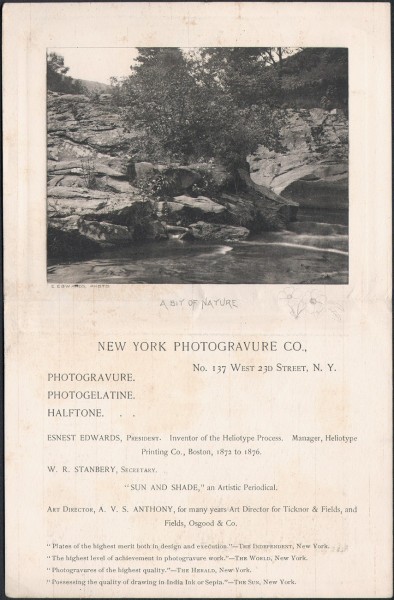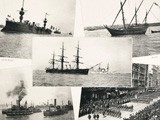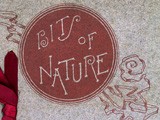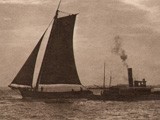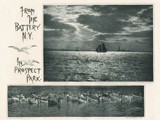New York Photogravure Company trade card
PhotographerErnest Edwards
CountryUnited States, England
MediumPhotogravure: Screen, Letterpress
EphemeraAdvertising Matter
AtelierN.Y. Photogravure Company (New York City)
Year1890
View Additional Information & Tags
Advertising, Engraving, Geology, Landscape, Rivers, Remarque, Supports
Dimensions
Image Dimensions: 8.5 x 10.8 cm
Support Dimensions: 21.4 x 13.9 cm plate paper, folded
This rare surviving fold-over trade card featuring an Adirondack or Catskills scenic photograph titled A Bit of Nature was used to promote the business interests of the New York Photogravure Company.
The Photo-Gravure Company was the first name assigned to the New York Photo-Gravure Co. in 1885 by founder and president Ernest Edwards, who had previously managed Boston’s Heliotype Printing Company from 1872-1885, when it declared bankruptcy. (1.)
The new firm was established that year on March 1st with offices at 853 Broadway in New York’s Union Square along with a printing plant in Brooklyn located at 3rd Ave. & 10th Street. Englishman Ernest Edwards (1837-1903) had previously made a name for himself in England as a portrait photographer of men of eminence, with Charles Darwin and Charles Dickens among clients. In 1869 he invented and soon patented the Heliotype Process, a collotype variation printing process.
The Photo-Gravure Company specialized in high-class printing, with photogravure, photogelatine (collotype) and halftone work a specialty. In 1887, the firm received perhaps the one commission it is known for today: the 781 collotypes done from copper plates making up the monumental publication:
Animal locomotion : an electro-photographic investigation of consecutive phases of animal movements, 1872-1885, with the landmark sequenced motion study photographs taken by British photographer Eadweard Muybridge. (1830-1904)
The New York Photo-Gravure Company: A Short Chronology
1885: opens for business on March 1 with business offices in Manhattan’s Union Square and printing plant in Brooklyn.
1888: On March 21, fire destroys the Brooklyn plant:
Fire broke out at 1:50 o’clock on Wednesday morning in the two story and basement frame house, Nos. 484 and 486 Third avenue, Brooklyn, which is leased by Ernest Edwards & Co. as a lithograph works. The flames caused a damage of $2,000 to stock and machinery and $1,500 to the building, which is owned by the American Lithograph Company, No. 59 Broadway. (sic) (2.)
Birth of Sun & Shade
Even with the story headline in the Brooklyn Daily Eagle newspaper declaring on March 21st: “Lithographic Works Almost Completely Destroyed This Morning”, the firm apparently managed to rise from the ashes in the same location. (3.) In July, a new folio monthly began publication called Sun & Shade: A Photographic Record of Events. Published with letterpress and advertisements, it featured lovely oversized hand-pulled photogravure plates as well as plates printed in photogelatine, (collotype) and halftone. Subject matter included the work of leading amateur and professional photographers, as well as works of art-many from the holdings of The Metropolitan Museum of Art in Manhattan. Success was swift. The first issue sold 1000 copies “in a fortnight” (4.) Sun & Shade, which changed its name to Sun & Shade: An Artistic Periodical beginning with the September, 1889 issue, would publish until at least March of 1896. (5.) In May that year, the N.Y. Photo-Gravure Company would close after declaring bankruptcy.
1896: In the weekly trade journal The American Stationer for May 21, it was reported the company had gone into receivership:
The New York Photogravure Company, at No. 137 West Twenty-third street, has gone into the hands of a receiver, Henry M. Denton having been appointed by Judge Pryor, on the application of the directors. Ernest Edwards is president and principal stockholder, having 274 out of 500 shares of stock. The embarrassment of the company is ascribed to the prevailing depression in trade, which has particularly affected business in the artistic line, poor collections and lack of capital. The company has a capital stock of $50,000, and the business has been established eleven years. Besides photogravure work the company also published a magazine called Sun and Shade. The liabilities are $30,180. The assets consist of plates, prints, machinery, materials, &c., estimated worth $6,074, and book accounts nominally $14,644. out of which the officers think that only $2,500 will be realized. (6.)
A New Company
Bankruptcy however did not prevent Ernest Edwards from, as a short mention in the Process Photogram and Illustrator tell it soon after-to rise from the ashes, and in the same building no less:
The N. Y. Photogravure Co. has recently been broken up, but only for re-construction, for out of its ashes has sprung the Photogravure and Printing Co., 137 West Twenty-Third-street, New York, which takes over the work of the late Company, and which is under the management /of Ernest Edwards, the president of the late Company. (7.)
1897: The firm moves to new quarters, to 241 and 243 W. 23rd St. in New York City, opposite “The Chelsea”, changing its name again to The Photogravure and Color Company. Edwards is now co-owner, along with Karl Arvidson, (b. 1859) who formerly worked with Edwards at Boston’s James R. Osgood Co. (8)
1900: At some point before or after the turn of the century, Ernest Edwards ceded controlling interest in The Photogravure and Color Company to Arvidson, but he is still listed with the occupation of engraver and living at his longtime home in Brooklyn at 367 Eighth St. (9.)
1903: Dies on March 10, 1903. (10.)
Ernest Edwards was celebrated shortly after his passing by the Booksellers’ League of New York:
THE BOOKSELLERS’ LEAGUE HONORS THE MEMORY OF ERNEST EDWARDS.
At a regular meeting of the Board of Managers of The Booksellers’ League, held on Thursday evening, May 7, 1903, Charles A. Burkhardt and W. H. Parker were appointed a committee to draft suitable resolutions of condolence and sympathy on the death of Ernest Edwards and to transmit the same to his family. The following was unanimously adopted:
Whereas it has pleased Almighty God to remove from among us our esteemed friend and associate, Mr. Ernest Edwards, it is Resolved, That in the death of Mr. Ernest Edwards the Booksellers’ League and the booktrade at large have lost one of its most distinguished members, one who was always ready to lend a helping hand in any undertaking to further the interests of his calling, and The Booksellers’ League in particular owes him a debt of gratitude, therefore be it further Resolved. That The Booksellers’ League extend to his family its deepest sympathy in their bereavement, which it shares with them only in a lesser degree, and a copy of these resolutions be spread in full on the minutes. (11.)
A note on this trade card: a typographical error spelling Edwards first name as ESNEST leads us to believe our date of circa 1890 is appropriate, although it could be earlier or later. Remarque of two flowers contained within lower right border of plate impression, with the very-finely done gravure revealing a dot pattern only under magnification. Further, Edwards was actually affiliated with Boston’s Heliotype firm until 1885.
Original copy for this entry posted to Facebook on Jan. 31, 2014:
Spurred by photographic historian Tom Yanul, I’ve posted some background on Ernest Edwards, (1837-1903) who founded The New York Photogravure Company in 1885 whose firm was in my estimation one of the most important printers of hand-pulled photogravure and collotype in the United States up to the turn of the new century. I have one very big request: for future posts and for posterity, does anyone know of a photographic likeness of Edwards? Tom and I have been searching high and low. One reportedly exists, taken probably in the early 1870’s after Edwards invented the Heliotype photographic process. It was done by portrait and landscape photographer J. Bowen of Kilburn, England (2 Priory Place) and sold at auction by Christie’s in 1992 (sale 4748, lot #120) along with other cdv’s of personages including Queen Victoria. Edwards is later identified as a heliophilist (!) in a biography of Edwards listed on the photoLondon website. Your help is appreciated!
Notes:
1. Advertisement in The Philadelphia Photographer: March, 1885. Period advertising material for New York Photo-Gravure stated Edwards was affiliated with this Boston company until 1886, however with the bankruptcy of the parent James R. Osgood & Co. firm of which Heliotype was a division, it would appear likely the 1886 date was a legal formality since the PP ad stated Edwards was “late of the Heliotype Printing Company.”
2. The American Stationer: March 22, 1888. The correct address was 591 Broadway.
3. Besides the business offices for the company at 853 Broadway, the address of 3rd Ave. & 10th St., Brooklyn, N.Y. appears on the September, 1888 issue of Sun & Shade.
4. notice: Sun & Shade: October, 1888. August and September issues did not appear.
5. A notice in the March, 1896 issue of Sun & Shade in the PhotoSeed archive states the April 1, 1896 issue would feature “seven high-class, copper plate Photogravures of M’lle Calvé (French opera singer Emma Calvé-1858-1942) in Operatic characters, besides a dashing Color Plate of her as “Carmen,” reproduced from Chartrau’s Painting.” It is unclear if this issue was ever published or the one for May, 1896 before the bankruptcy.
6. notice: The American Stationer: New York: May 21, 1896: p. 886
7. The Process Photogram: unknown monthly 1896 issue: p. 158
8. advertisement: The Publishers’ Weekly: May 15, 1897. : p. 834
9. see the volume: Brooklyn Ordinances, Resolutions, Etc, Volume 4 (1900)
10. Ernest Edwards: State of New York: Certificate and Record of Death: Edwards died of a cerebral tumor with his remains cremated. He was survived by wife Elizabeth. certificate courtesy photographic historian Thomas G. Yanul.
11. notice: The Publishers’ Weekly, May 16, 1903: p. 1171
